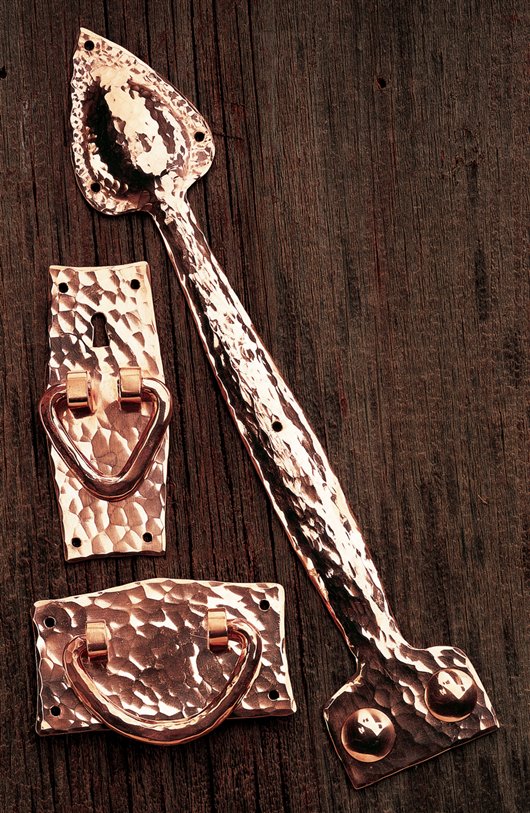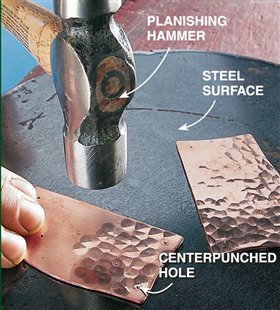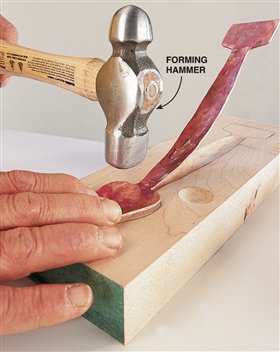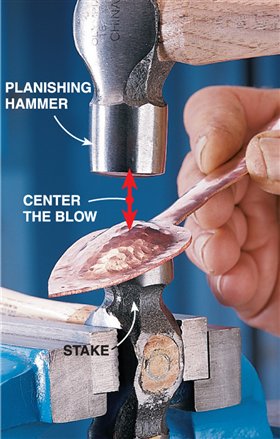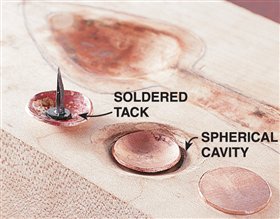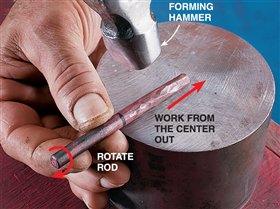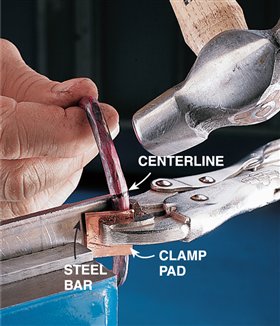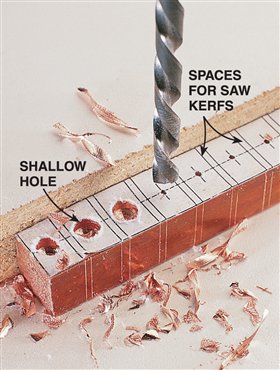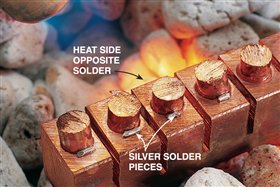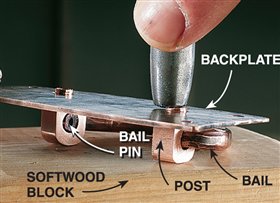Hardware doesn’t have to come from a catalog.
You can make your own. The raw materials are
inexpensive and you won’t have to buy lots of
special metalsmithing tools, because most
of the things you’ll need are already in
your shop. Learning the techniques for
working copper can be rewarding and
fun. Annealing and work hardening
were new to me, and may be to
you, but cutting, hammering,
and drilling are familiar to
woodworkers.
Working copper is a blast!
I was pleased with the very first copper piece I made, and my
results kept getting better the more I practiced. Once you’re
familiar with the techniques, you’ll be able to make all the
hardware for the AW Stickley-Style Sideboard project (available
from awbookstore.com)—or just about any Mission or Arts and
Crafts style piece of furniture in a couple of weekends. If you
decide to try making your own, I guarantee that you will enjoy
the process and be thrilled by the results.
Materials and sources
For the AW Stickley-Style Sideboard, you’ll need 2 sq. ft. of 48-oz.
copper sheet stock (.064 gauge) for hinge straps and backplates,
3′ of 5/16″ copper rod stock (AISI grade #110) for bails, 10″ of
1/2″ x 1/2″ copper bar stock for posts, and 10″ of 4-gauge copper
grounding rod for post pins (Photo 19). Sheet metal and architectural
metal fabricators are often willing to sell the small amounts
of sheet stock you’ll need. Rod and bar stock is harder to find.
Try salvage yards or order through the mail (see Sources).
Grounding rod is available anywhere electrical wiring supplies are
sold. You’ll also need pickling flux and silver solder, and perhaps
a patinizing solution (see “The Look of Aged Copper”). All of
these things are also available through the mail (see Sources).
Tools
The only specialized tools you’ll need to work the copper are
hammers and a punch, something to pound on, a heat source,
and places to heat and cool the metal.
You can buy real metalsmithing hammers (see Sources),
or use some elbow grease and make your own from inexpensive
16-oz. ball peen hammers. Be sure to wear eye protection when
you try this.
Reshape one flat hammer face into a shallow dome (Fig. A,
Planishing Hammer) using a disc or belt sander. The shape of the
dome determines the size of the mark. I found a 5/16″ dia. mark
the most attractive. Some areas that need texture are too small for
the planishing hammer, so I domed the tip of a length of steel rod
(Fig. A, Mini-planisher). Shape the face of the second hammer
into a shallow-domed rectangle that slopes toward the handle
(Fig. A, Forming Hammer). To quickly get the rectangular shape
on this one, I cut away the unnecessary steel with a 4-1/2″ cut-off
wheel in my grinder/sander before moving to the disc sander for
final shaping. You can do this whole job on the disc sander, but
it will take longer. A third hammer face remains flat. Smooth and
polish all of these faces with an orbital sander, working through
sandpaper grits up to 600. Any blemishes left on the hammer faces
will be transferred to the copper.
To achieve a crisp texture on the copper you must hammer
it on a hard surface. Wood is not hard enough. I used a piece of
1/2″ steel plate for the hinge straps and backplates (Photo 2) and
a massive steel block for the bails (Photo 13). I bought both at a
salvage yard for next to nothing. Raising the crowned shape of the
hinge straps and bolt heads can be done using a piece of maple
1-3/4″ x 4″ x 12″ (Photo 5) as a forming block.
You’ll need a high-output, self-starting torch and a tank
of MAPP gas to get the copper hot enough to anneal it—
propane won’t do. I made my own annealing tray by filling
an aluminum cake pan with pumice stones (see Sources,
p. 8) and used a plastic container for the quenching bath. |
|
Click any image to view a larger version

1. Saw the hardware pieces following paper patterns
fixed to the copper sheet with spray adhesive. Copper
is soft enough to cut on a bandsaw using a generalpurpose,
fine-tooth blade. Centerpunch all drill hole
marks on the patterns, smooth all burrs and refine
the edges with abrasives or files. Remove paper and
adhesive residue, then polish the copper faces with
400-grit wet/dry sandpaper.

2. Create a hammered
texture by striking the
copper with a planishing
hammer on a flat steel
surface. Be sure to
hammer the face—the side
with the centerpunched
holes. Practice hammering
on scraps so you can get
a feel for the metal and
develop a hammering
rhythm. Slightly overlapping
each stroke creates a
nicely balanced look.

6. Pound an annealed strap
into the forming block to create
the raised center. Use the forming
hammer. The strap will bend
dramatically as it is worked, but
you can flatten it by gently tapping
its top side with a non-marring
mallet. Anneal the copper when it
becomes work hardened (see “The
Annealing Process”).

8. Hammer texture marks
onto the convex profile at the
tip of the freshly annealed hinge
strap. A ball peen hammer held
in a vice serves as a stake—an
anvil for texturing a curved object.
Make sure each blow of the
planishing hammer is centered
on the stake hammer below. As
you work, move the hinge strap,
not the hammer, for each blow.
Use the forming block to flatten
the tip if it distorts.

11. Hammer penny-sized polished
copper discs into a spherical cavity
in the forming block with the ball peen
hammer. Center a steel tack in the
concave backside and silver-solder it
in place.

13. Pound around the annealed rod with the forming
hammer to lengthen and taper it. Work from the center
out, and rotate the rod with each blow. It will take four
to five courses of pounding and annealing to achieve the
final length and the desired taper.

16. Start the bend of the door’s
V-shaped bail by pounding it, freshly
annealed, over a 1″ x 1/4″ steel bar
clamped so its edge is slightly below the
bail’s centerline. Anneal the bail when
you sense work hardening. Frequent
annealing assures that bends occur
where you want them. Repeat the
process of annealing and bending until
the final V-shape is attained. Make sure
the pins align.

18. Drill holes in copper bar stock that
has been divided into 1/4″ sections,
leaving room for saw kerfs between them
(Fig. B, posts). These shallow holes,
which are centered in each section, will
have pins soldered into them. After
drilling, carefully saw between each post
from the pin end, stopping two-thirds
of the way through. This establishes
the individual posts, but keeps them
connected and easy to handle.

20. Solder the pins
in place. First coat
all pieces with flux
and hammer the
pins in place. Place
a sliver of solder at
the junction of each
pin and post. Then
heat the bar, holding
the torch on the side
opposite the solder,
until the solder flows
into the joints. Heat
the metal, not the
copper, and don’t
overheat. After soldering, sand the pins so they’re slightly longer than the thickness
of the backplates. Then drill shallow 5/32″ dia. holes in the end of each one
to facilitate riveting (Photo 22 and Fig. D).

23. Rivet posts to
the backplate. First
position posts on
the pins at the ends
of a bail. If the bail
pins are properly
bent, the posts will
align parallel to one
another. Make necessary
adjustments
before positioning
them on the backplate. Work on a softwood block so the
bail holes in the posts are not distorted. If you don’t have
three hands, get help from a friend. |



